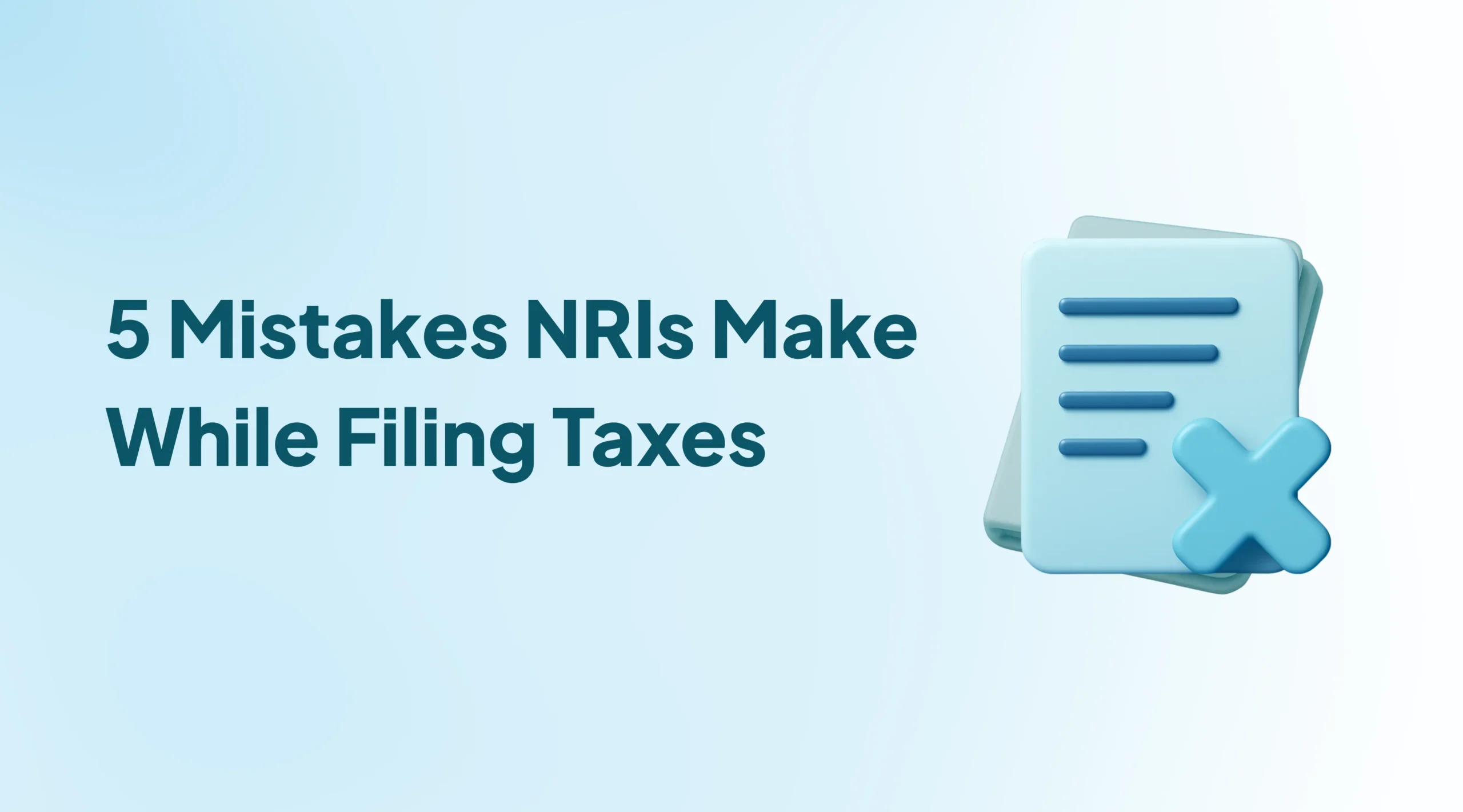Filing your taxes as an NRI can feel like you’re walking through a maze blindfolded. One wrong turn and you end up facing penalties, notices, or delayed refunds that can drag on for months. Over the years, I’ve seen countless NRIs from first-time filers to seasoned professionals—fall into the same traps over and over again.
Today, let’s walk through the five most common and costly mistakes NRIs make when filing their Indian tax returns. I’ll also share how you can avoid these pitfalls and file with confidence.
1. Miscalculating Residential Status
You’d be surprised how often this happens. Many NRIs assume that the moment they board a plane out of India, they automatically become a non-resident. But the truth is, your airline ticket doesn’t decide your residential status—it’s decided by the number of days you’ve stayed in India during a financial year and the preceding years.
Why It Matters
Your residential status affects everything:
- Which income is taxable in India
- Which exemptions can you claim
- Whether you must report global income
For example, if you spend more than 182 days in India in a given financial year, you’re typically treated as a resident. But it gets trickier if you’ve been in India for 60 days and also spent 365 days in the preceding four years. Many NRIs miss this calculation entirely. I once spoke to a client who thought he was an NRI for years, only to discover he was actually a resident and ordinarily resident for tax purposes. He ended up with a massive tax demand and a headache that lasted months.
How to Determine It Correctly
You don’t need to be a tax wizard to figure this out. Keep a record of your travel dates, including arrival and departure stamps. Use the official CBDT guidelines to tally your days. If your situation is borderline—say, you travel frequently—get help from a professional before filing. This one step alone can save you from unexpected tax on foreign income.
2. Choosing the Wrong ITR Form
Imagine spending hours collecting documents, filling out forms, and uploading details—only to realize you filed the wrong return. This mistake is more common than you’d think. The Income Tax Department prescribes different forms based on your income sources and residential status. NRIs often pick ITR-1 out of habit because it seems the simplest, but that’s usually the wrong choice.
Common Wrong Selections
ITR-1 (Sahaj) is only for resident individuals with income up to Rs. 50 lakh from salary, one house property, or other income like interest. NRIs cannot use ITR-1 if they have:
- Foreign income
- Capital gains
- Multiple house properties
- Business income
But many NRIs don’t realize this. A client once told me, “I always used ITR-1 when I was in India, so I kept doing it.” He didn’t know that the wrong form can invalidate the return and delay refunds.
Which Form NRIs Should File
If you’re an NRI with income from salary, rent, or investments in India, you will generally file ITR-2. If you also have business or professional income, you will need ITR-3. Before you start, check the latest CBDT notification or the Income Tax e-filing portal to confirm which form applies. Picking the correct form is the foundation of a valid return.
3. Failing to Properly Claim DTAA / Foreign Tax Credits
Double taxation is the NRI’s biggest headache. You earn in the UK or the US, pay tax there, and then get taxed again in India on the same income. That’s where the Double Taxation Avoidance Agreement (DTAA) comes to your rescue. But the process isn’t automatic—you must claim relief and submit supporting documents.
Form 67 & Form 10F Importance
If you’re claiming foreign tax credit, you must file Form 67 before your return. Skipping this form means your credit claim is invalid. Also, many NRIs forget to submit Form 10F along with a valid Tax Residency Certificate (TRC) from their country of residence. Without these, the Indian tax office simply disallows the DTAA benefit.
I’ve seen clients lose thousands because they missed a simple upload. One person I helped had paid US federal tax on dividends but didn’t file Form 67 on time. As a result, he had to go through a tedious rectification process.
Missing Tax Residency Certificate
A TRC proves you really are a resident of the foreign country you’re claiming credit from. It’s usually issued by your foreign tax authority, like the IRS or HMRC. Without it, the Indian tax department treats your income as fully taxable. Always plan early. It can take weeks to get this certificate.
4. Not Reporting All Indian Income
This mistake is the silent killer. Many NRIs assume that if their income is small or tax has already been deducted at source (TDS), they don’t need to declare it. That’s not true. Every rupee of Indian income must be reported, even if tax was already deducted.
FD, NRO Interest, Property Income & TDS Traps
Let’s say you have a fixed deposit in India earning interest. Your bank will deduct TDS, but you still have to disclose the income in your return. Same with rent from property or gains from selling shares. The tax department now cross-checks your PAN with information from banks, property registrars, and brokers. If you skip reporting, expect a notice.
One NRI client sold a flat in Pune and thought the buyer’s TDS covered everything. But he didn’t file Form 26QB correctly to report the transaction. Months later, he got a demand for unpaid capital gains tax. That notice alone was 20 pages long.
Capital Gains & TDS Form Errors
Whenever you sell property, the buyer must deduct 20% TDS. But you still must calculate your actual capital gains and report it. If you under-report or forget, penalties can stack up fast.
5. Missing Deadlines & E-Verification
Even if you do everything else right—choose the correct form, claim credits, report income—your return won’t be processed unless you file on time and e-verify. This last step sounds trivial, but every year, thousands of returns stay pending because people forget to e-verify.
Filing Window & Late Fees
The usual filing deadline for NRIs is July 3,1, following the end of the financial year. If you miss it, you can file a belated return by December 31, but late fees apply. For higher incomes, the late fee can be up to Rs. 5,000. And if you miss even the belated deadline, you can’t file a return at all except in limited cases.
Final E-Verify Step
E-verification is like sealing the envelope on your return. Until you do it, your return is considered invalid. You can e-verify via Aadhaar OTP, net banking, or by mailing a signed ITR-V form to CPC Bangalore. Always do this step right after filing. It takes two minutes but saves months of trouble.
Bonus Mistake: Maintaining Poor Documentation
Many NRIs treat tax paperwork as something to stash in a drawer and forget. But if you ever face a scrutiny notice, you’ll need clear records:
- Bank statements showing credits
- Form 16A TDS certificates
- TRC and Form 67 acknowledgments
- Purchase and sale deeds for property
A well-organized file makes your life easier. Think of it like an insurance policy against confusion later.
Final Checklist: Avoid NRI Tax Pitfalls
Before you hit submit, pause and run through this checklist:
- Have you calculated your residential status correctly?
- Are you using the right ITR form?
- Did you collect your TRC, Form 10F, and file Form 67 if needed?
- Is every Indian income reported, even the small bits?
- Did you file before the deadline and complete e-verification?
- Have you saved every supporting document safely?
Tick all these boxes, and you’ll be in good shape.
FAQs
What if I missed the filing deadline?
If you miss the July 31 deadline, you can still file a belated return until December 31. However, you’ll pay a late filing fee ₹. 1,000 if your total income is under Rs. 5 lakh, or Rs. 5,000 if it’s above that. Also, you won’t be able to carry forward certain losses (like capital losses) if you file late. If you miss the December 31 cutoff as well, you must wait for a notice from the tax department to allow you to file, which is much more stressful. In some cases, you can request a condonation of delay, but you’ll need to provide a valid reason.
How do I claim a refund on excess TDS?
Even if your bank deducted TDS on your NRO account interest or property sale, that doesn’t mean you don’t need to file. You must still report the income in your return, calculate your total tax liability, and claim a refund for any extra tax paid. The refund is issued electronically after the Income Tax Department processes your return. Always ensure your bank details and PAN are correct so there are no delays.
Can DTAA apply automatically?
No, DTAA benefits don’t kick in by themselves. You must actively claim them in your return. That means getting a Tax Residency Certificate from your country of residence, filling Form 10F, and filing Form 67. Without these, Indian tax authorities will tax you as if there is no DTAA.
What triggers an NRI tax notice?
Several things can attract scrutiny:
- Large property transactions without clear reporting
- Mismatch between TDS in Form 26AS and your return
- Not reporting NRO account interest
- Failing to declare capital gains
- Claiming DTAA relief without documentation
Most notices aren’t the end of the world if you have proper records. But ignoring them or replying late can escalate into penalties.


0 Comments